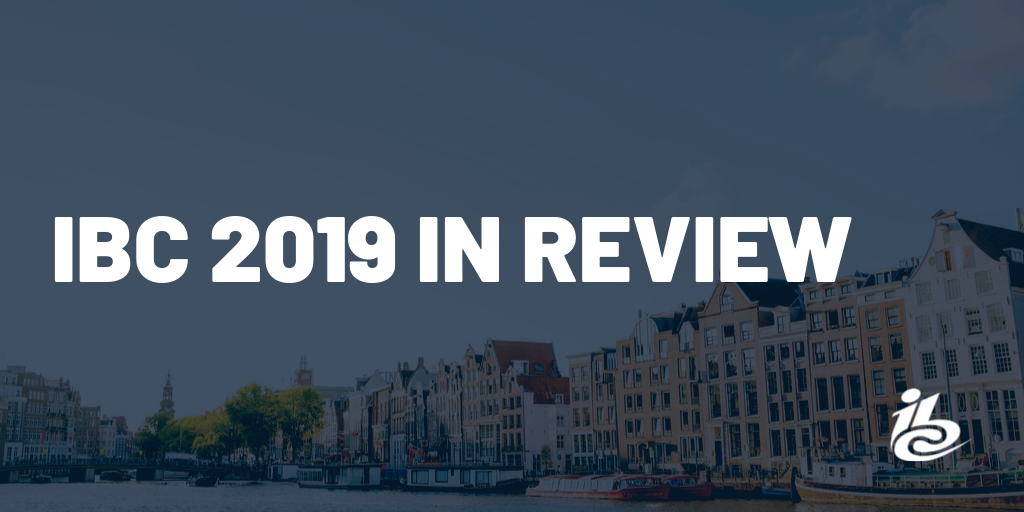Now that the dust has settled on this year’s IBC show, we at Varnish wanted to highlight some key trends that we saw and heard being discussed at the conference and on the show floor for those of you who may not have been able to make the trek to Amsterdam. This year, it was just as interesting to see what didn’t end up making a prominent appearance at the event as what did. Here are our five key observations:
Competition may be increasing but key challenges remain the same
It must be said, there wasn’t a huge amount of change from what was on show two years ago compared to what was at IBC this year. Media businesses of all kinds are facing similar sets of issues – the challenges of 4K (and to a much lesser extent, 8K) delivery and storage, how to handle latency and overcoming bandwidth challenges remain a thorn in everybody’s side.
We have, however, seen a dramatic increase in the number of vendors entering the market, particularly those offering end to end solutions designed to satisfy the needs to of the growing range of direct to consumer offerings that are now available to users. As services like Hulu broaden their catalogs, and Disney+ prepares for its imminent launch, the opportunities for niche content offerings focused on satisfying a focused audience are more numerous now than ever before. As a result, ensuring smooth, stable and responsive content delivery is as important now as it ever has been.
Streaming must go beyond broadcast
Slogans like ‘next-gen TV’ and ‘beyond broadcast’ dominated the sides of stands at IBC this year, with a growing number of service providers seeking to not only meet current broadcast-standard quality, but to exceed it. With nearly 60% of Americans now streaming content regularly, the competition for eyeballs has never been hotter. As a result, services looking to rival the viewing figures of traditional broadcasters and pay-TV services are now focussing on exceptional quality and value-added services.
The likes of Amazon Prime Video, Netflix, Rakuten, Hulu and YouTube have been offering an abundance of 4K content on-demand for some time, yet it is 4K live streaming that still presents the biggest challenge, and places huge demands on CDNs. This is slowing the ability of broadcasters to offer some of the biggest events – like the Super Bowl – in 4K, (though Fox did recently announce the screening of Thursday Night Football in 4K HDR) but streaming customers are becoming ever more impatient in their demand for high-quality streamed content.
Latency cannot be low enough
One word we saw, heard and read about throughout IBC2019, was latency. And one use case in particular that came up time and again was the challenge of delivering live content (especially sports) to viewers in the best possible quality, and with the lowest possible latency.
Ben Freeman, VP Product, Playback, Advertising and Living Room, at DAZN used the streaming of Serie A football in Italy as a good example. Italy is a varied country, and connectivity and infrastructure quality differ massively depending on the region in which the viewer is based. The further south you go, the worse the connectivity and quality get, yet football fans still all have exactly the same expectations – no matter where in Italy they are based.
Exact schedules for sports in both Europe and the US are not often revealed months in advance, which adds pressure onto companies like DAZN to conduct capacity planning in collaboration with its CDN partners. The key is to use a CDN that leverages strategically located points-of-presence (PoPs), which moves content distribution closer to the viewer. The closer the content is, the faster it’s delivered to the audience with minimal possible network latency. If we continue to look at the example of Italy though, in the south there is a lack of large CDN PoPs. So in this case, it’s possible to build out local PoPs, or look to peer-to-peer CDNs to guarantee bandwidth, ensuring viewers across the whole country experience the same, high quality viewing experience.
CDNs aren’t always as turnkey as they seem. With so many different vendors peddling products at IBC2019, it’s worth service providers remembering: it’s not just the CDN they choose, but the capacity planning they must conduct that will make the difference.
Tackling demand peaks still an issue
This brings us to the other half of the live streaming challenge: managing peak demand. In addition to having to deliver live content to hundreds of thousands or potentially millions of concurrent viewers, live streaming has to overcome a secondary challenge: unplanned demand spikes. Millions of viewers who are keen to catch the opening of a match will tune in at near enough the same moment, putting massive demand on the service. Things like extra time, sudden comebacks, or a player having the performance of their life can also cause audience numbers to skyrocket – something broadcasters must always be prepared for.
Loyal fans (and not to mention advertisers paying premium rates for top ad slots) have high expectations, so the need to deliver a first rate viewing experience is paramount – failure to do so will result in viewers tuning out and advertisers not getting ROI on their spend. New Zealand’s Spark Sport recently ran into this issue, streaming a opening rugby match against South Africa, only for viewers to be confronted with error messages, delays and buffering freezes. Given the importance of the game to rugby fans, it’s no surprise that there were over 10,000 complaints.
Personalization and 5G make less of a splash than expected
In a step change to previous IBCs, there was less emphasis on personalization than usual – especially in relation to advertising – which may be a response to the new GDPR regulations that have come into place in Europe. Though this may indicate a trend change – many viewers are comfortable with current levels of personalization, and the thought of their data being used to be even more predictive about their habits could come across as creepy. We’re also seeing a general shift in focus away from personalization, and towards the importance of delivering content reliably, securely, and with lower latency – regardless of where in the world viewers are streaming. We saw a greater number of exhibitors looking at tools that make remote OTT live editing and scene selection easier without having to invest in expensive onsite video production trucks.
The other ‘trend’ which didn’t quite make the cut as expected was 5G. We’ve seen an increase in the number 5G network roll-outs since the beginning of the year, however, the only companies really doing 5G at present (and promoting this at the show) were big names from Korea, Japan and China. This is a similar story with 8K, although BT did demonstrate an 8K live stream during the show. With all this innovation coming from the Far East, don’t be surprised if more of those companies based in the Western hemisphere begin making inroads into this exciting new market very soon.
One important point to mention, though, was 3GPP’s release during the show of new 5G media service architecture. Features such as network slicing, distributed and mobile edge compute will – in the future – improve the quality and efficiency video streaming services. And – even further in the future – support the emergence of services like 360-degree VR, augmented reality and mixed reality applications.
/VS-logo-2020-197x60.png?width=136&height=60&name=VS-logo-2020-197x60.png)



